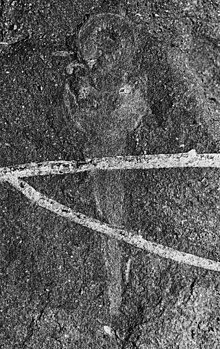Priscomyzon riniensis
|
Priscomyzon Temporal range: Late Devonian Famennian |
|
|---|---|
 |
|
| holotype | |
 |
|
| Line drawing reconstruction | |
| Scientific classification | |
| Kingdom: | Animalia |
| Phylum: | Chordata |
| Class: | Hyperoartia |
| Order: | Petromyzontiformes |
| Genus: |
Priscomyzon Gess et al., 2006 |
| Type species | |
|
Priscomyzon riniensis Gess et al., 2006 |
|
Priscomyzon riniensis is an extinct lamprey that lived some 360 million years ago during the Famennian (Late Devonian) in a marine or estuarine environment South Africa. This small agnathan is anatomically similar to the Mazon Creek lampreys, but is some 35 million years older. Its key developments included the first known large oral disc, circumoral teeth and a branchial basket.
Though common and diverse during the Silurian and Devonian, jawless fish are today represented only by lampreys and hagfish, both groups being quite specialized. Lampreys have seven gill pouches (whereas jawed fish have only five), no paired fins, and a rudimentary skeleton of cartilage. They also have a sucker disc of cartilage surrounded by a soft lip and a central small mouth set about with simple hooked teeth. They attach to the bodies of other vertebrates by suction, securing their grip with the hooked teeth, after which a rasped tongue scrapes a hole providing access to the host's softer tissues.
Priscomyzon provides evidence that agnathans close to modern lampreys had existed before the end of the Devonian period. Lampreys have ancient origins, have endured for 360 million years and lived through four major extinction events - even so, their evolutionary history is obscure. In ancient seas jawless vertebrate fish led to jawed fish, and thence to all other vertebrates, including humans. Being the only extant jawless vertebrates and a virtual time capsule of embryology and DNA, lampreys and hagfish are of immense scientific interest. Knowing the period during which they became parasitic would shed light on how typical they are of ancient fish. Being essentially boneless, their cartilaginous framework leaves almost no fossil record - a mere three fossil species had previously been described, and in none of these was a sucker disc detected.
The exceptionally well-preserved fossil of P. riniensis is only 42mm long and reveals details of its fin, gill basket and mouth region. A striking feature of Priscomyzon is its relatively large oral disk, inside a soft outer lip, supported by annular cartilage. The circular mouth at the center of the oral disk is surrounded by 14 small, evenly spaced, simple teeth, with no associated radiating series or plates of supplementary teeth, but otherwise quite similar to present-day lampreys, suggesting that their blood-sucking lifestyle was developed in ancient seas. The oral disk of the Late Carboniferous lamprey Mayomyzon pieckoensis, if present, is much smaller, while there is no evidence of a disk in the Early Carboniferous Hardistiella montanensis. Priscomyzon's are the earliest teeth found in any fossil lamprey, and have a similar arrangement to that of the 19 or more teeth found in modern forms such as Ichthyomyzon, Petromyzon, Caspiomyzon and Geotria.
...
Wikipedia
